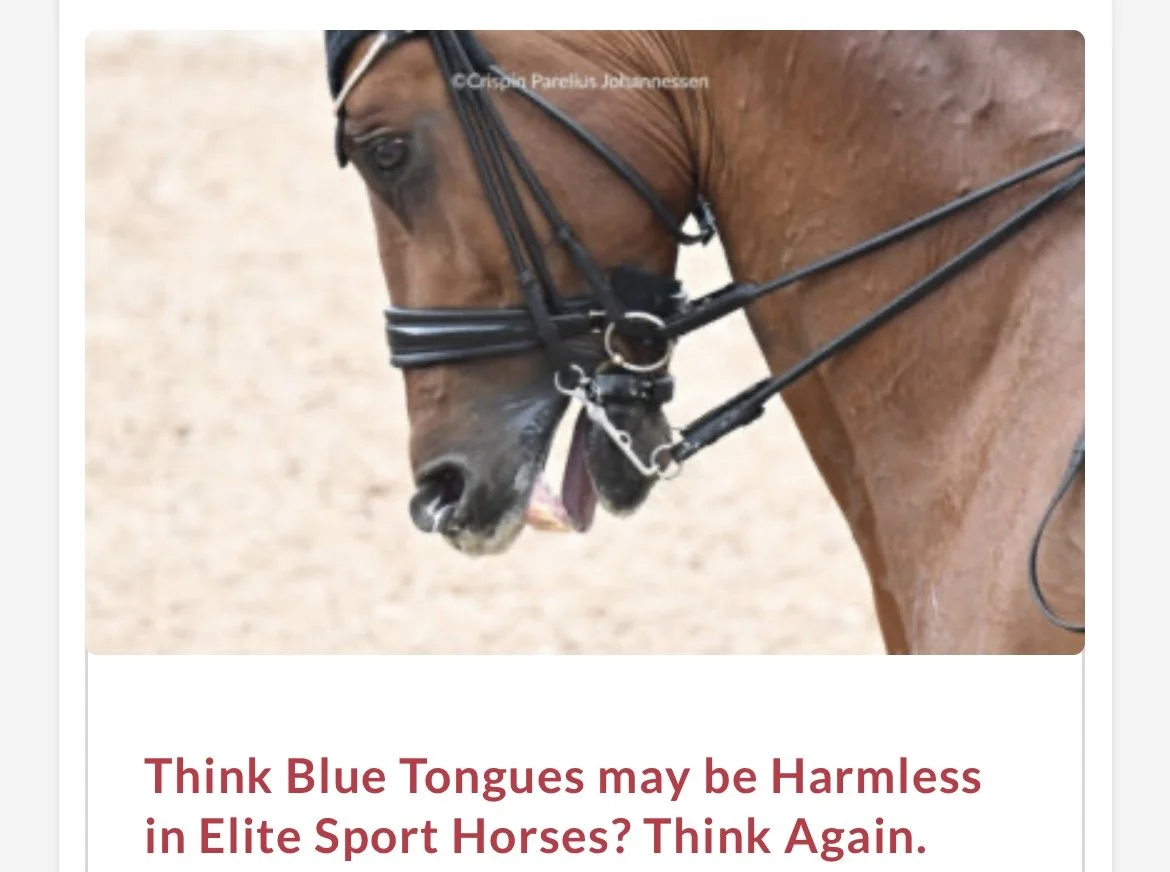-

The FEI’s Blood Rule: Are We Really Willing to Jump Backwards? Cristina Wilkins | Oct 21, 2025 |
Next month, the FEI is expected to approve a rule change that would downgrade visible bleeding from the horse’s mouth or nose from an elimination offence to an administrative warning – effectively lowering the stakes for riders, and placing the sport’s “welfare is paramount” rhetoric at odds with its fragile social licence.
-

Think Blue Tongues may be Harmless in Elite Sport Horses? Think Again.by Dr James Cooling | Oct 9, 2025 |
A medical doctor explains why tongue discolouration isn’t cosmetic—and what it reveals about equipment, anatomy, and welfare.
As a medical doctor, qualified horse trainer, human personal trainer, and bit and bridle fitting consultant, Dr James Cooling brings a rare and valuable perspective to the recent controversy in international horse sports: the emergence of “blue tongue” in elite sport horses—not because it’s new, but because, thanks to high-speed photography, we’re finally seeing it. In this article, he explains why even a fleeting glimpse of this phenomenon is far from trivial, and what it reveals about equipment, anatomy, and horse welfare. With social licence under growing pressure, his analysis couldn’t be more timely.
Drawing on physiology and anatomical insight, and decades of medical evidence, Dr Cooling explores how tongue discolouration occurs, why it signals compromised welfare, and how in combination with noseband pressures, a bit can act like a tourniquet inside the horse’s mouth. From the physiology of cyanosis to the ethics of judging practices, this is a deep and essential examination of a problem that must not become normalised.
-

The Mouth-Iron-Free Solution for Sudden Death in the Racehorby Dr Robert Cook, FRCVS, PhD | Oct 6, 2025 |
This final paper by the late Dr William Robert “Bob” Cook (1931–2025) brings together a lifetime of research and advocacy for horses’ welfare. In his last days, Dr Cook entrusted this work to Horses and People, wishing it to stand as the culmination of his efforts to “unshackle the horse.” His family shared that he was overjoyed to know it would be published.For more than fifty years, Dr Cook challenged long-standing equestrian traditions with evidence that bits harm horses and bit-free riding improves comfort, performance, and safety. It is published here in tribute to a scientist, teacher, and advocate whose compassion and persistence continue to shape the future of horse welfare.
-

Bit Blindness and Questioning the Concept of Pain-induced Musculoskeletal Lameness. Posted by Professor Emeritus David Mellor | Dec 10, 2024 |
The term “bit blindness”, coined in 2020, emphasises that after its inception four millennia ago, bit use in horses has long been normalised [1,2]. Moreover, not only has the use of bits been normalised, so too were the distinctive behaviours associated with that use. Indeed, this dual normalisation was so widely accepted that when published evidence increasingly showed bit-induced mouth pain was the cause of clearly identifiable behaviours within the normalised spectrum [e.g., 3-11], it shocked equestrians who believed it [12].
-

Bit-Induced Mouth Pain and Wider Equine Welfare Assessments Ignored in a Paper on Bridle and Bit Fit. Posted by Professor Emeritus David Mellor | Dec 9, 2024 |
In this compelling critique, Professor Emeritus David Mellor examines a recent study published in Animals by Kathryn Nankervis, Jane Williams, Diana Fisher, and Russell MacKechnie-Guire. Mellor questions the almost complete absence of references to bit-induced mouth pain, and a failure to comprehensively evaluate the associated welfare concerns. -

Double Bridles - The Curb Bit is a Nutcracker. Posted by Cristina Wilkins 20th October 2024.
Curb bits are very powerful, second-class levers of the 'nutcracker' or 'lemon squeezer' type. They are literally a 'tongue, lips and bars squeezer'. They are meant to enforce poll flexion with minimal rider effort - through pain or the threat of pain as the mouthpiece compresses the tongue, lips and bars. Like all bits, curbs ARE A WELFARE RISK Horses are at risk because riders can easily underestimate the mechanical advantage and how it amplifies the pressure the horse is receiving on sensitive tissues.
-

Nosebands: Accessories to the (blue-tongue) crime? Posted by Cristina Wilkins 6th August 2024.
Some dressage horses, even Olympic champions, have blue tongues when they are ridden. Why is this happening? This video exposes some of the evidence, and suggests that tight nosebands are at the centre of the problem - aiding and abetting training practices that are leading to blue tongues; which means that some riders may not realise this is likely to violate the animal welfare legislation in many countries they compete in. This is not good news, for the horses, riders, the sport, and all the businesses who rely on them.
-

Social Licence to Operate and Equipment Use in Horse Sports
This video explains what the social licence to operate is; why it affects horse sports, and why tack and equipment is at the top of the FEI's priority list for welfare reform. I presented this at the Horse Welfare Conference 2024, hosted by the Danish Knowledge Centre for Animal Welfare and the Centre for Research in Companion Animal Welfare. The conference sold out in less than two weeks, demonstrating the strong interest in horse welfare.